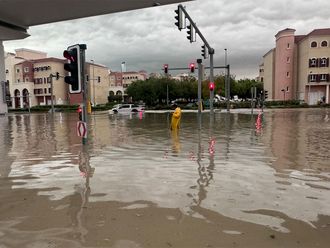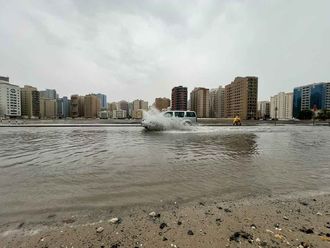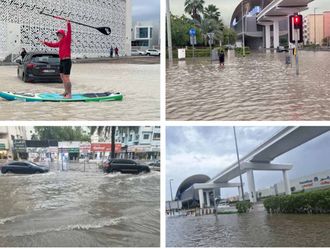
Navigating through global financial volatilities and facing slower trade flows with important global regions such as the US and the EU, the UAE has shown remarkable resilience over the past few years and is continuously demonstrating its proactive role on the global economic stage.
Owing to its stable economy and sound policies, it is again marking its role as one the world’s most vibrant economies. Economists have raised their forecasts for UAE growth in the coming year, as higher oil output helps safeguard against the effects of a slower global economy.
GDP expansion is estimated to reach between 3 and 4 per cent in 2013, up from previous forecasts of around 2.6 per cent. Moreover, the nation has maintained its position as the top Arab country in terms of commercial exchange, which exceeded $490 billion (Dh1.79 trillion) in 2011, accounting for nearly a quarter of the region’s total trade, according to official data.
The World Trade Organisation said the UAE accounted for more than 1 per cent of the world’s total imports of goods of around $15.37 trillion and 1.5 per cent of the global exports of $15.23 trillion.
Looking ahead, the International Monetary Fund estimates that the UAE could become the 30th largest global economy in 2016, rising seven places since 1987.
Another example of the UAE economy taking huge leaps forward is investment activity in the oil sector. Abu Dhabi’s investments in its hydrocarbons sector grew to a record high of more than $13 billion at the end of 2011. The investments last year were nearly 11.5 per cent above the capital at the end of 2010 and almost seven times the emirate’s oil investment in 2005, according to the Abu Dhabi Statistics Bureau.
Furthermore, consumers and businesses in Dubai are showing renewed confidence and are facing a brighter outlook on jobs and spending, according to the quarterly Consumer Confidence Index published by the Department of Economic Development. Overall consumer confidence recorded in the emirate during the third quarter was 129, well above the average of 100 and seven points higher than in the second quarter.
Stable outlook
“Over the next few years, economic prospects for the UAE look healthy,” Trevor Cullinan, Director — Sovereign Ratings at rating agency Standard & Poor’s, tells GN Focus.
“As with other hydrocarbon-rich GCC economies, the UAE appears well positioned to benefit from high oil prices, which in our base case we expect to be maintained above $100 over the medium term. Our current sovereign credit ratings for UAE emirates are Abu Dhabi AA/Stable/A-1+ and Ras Al Khaimah A/Stable/A-1. The stable outlooks indicate that we currently do not expect to raise or lower these ratings in the next two years,” Cullinan adds.
Rick Pudner, CEO of Emirates NBD, is of a similar opinion. “We believe that the UAE’s economy has been resilient to the global slowdown in 2012, as oil production has supported growth,” Pudner tells GN Focus.
“Tourism, hospitality and trade have also performed well this year. Looking ahead, we expect oil production to stabilise, and we think the UAE’s growth in 2013 is likely to be driven by government spending and the non-oil sector.”
Emirates NBD expects UAE real GDP growth to accelerate to 3.5 per cent in 2013, from about 3 per cent this year. National Bank of Abu Dhabi says in its latest regional economic outlook report that it expects GDP growth to reach 3.3 per cent this year, up from a previous forecast of 2.6 per cent.
British bank Barclays expects the UAE’s growth to be around 3.2-3.5 per cent in 2013, as the expansion in oil production moderates compared to 2012 and with credit growth likely to remain subdued.
“We are expecting the UAE economy to sustain and see a moderate growth momentum, against the backdrop of strengthening balance sheets in the public and financial sectors, supported by higher oil prices and robust current account and fiscal surpluses,” Khalid Abdullah, spokesman for Barclays Middle East, tells GN Focus.“We expect the recovery to be driven by Dubai’s services sector, notably trade, tourism, transport and financial services.”
Pudner says government spending will be one of the driving forces for the UAE in 2013, as authorities move ahead with key infrastructure projects and increased social spending. “Regional GCC demand is likely to remain strong next year, and this should support growth in the UAE’s tourism, services, trade and logistics sectors,” he adds.
The financial sector will also play an important role in GDP growth.
Khalid Howladar, Vice-President — Senior Credit Officer at rating agency Moody’s, says he expects credit growth to reach around 5-10 per cent in 2013, mostly driven by Abu Dhabi banks.
“For the UAE banks [in general] we have a mixed picture — Abu Dhabi banks are recovering stronger, but we are still cautious regarding Dubai banks, due to legacy problems,” Howladar tells GN Focus.
His expectations for the UAE’s GDP growth in 2013 are “around 3 per cent, with core sectors being trade, travel, tourism and retail”.
Cullinan identifies the same sectors as the most promising. “We expect the economic expansion to be fuelled by the continued recovery in non-oil sectors such as tourism and the service sector more generally, and to remain supported by high oil prices,” he says.
Cullinan’s growth expectations for the UAE in 2012 are 3.1 per cent “before a modest rebound to 3.5 per cent in 2013”.
External demand
HSBC is even more confident about the UAE’s growth. The bank has put its GDP growth forecast at 3.7 per cent in 2012 and 4 per cent in 2013, according to its latest quarterly Middle East Economics review.
It says the country has shown resilience over the first nine months of 2012 “despite being more exposed to the European slowdown than any other Gulf country”.
Simon Williams, chief economist for Middle East and North Africa at HSBC, notes in the review that the UAE continued to rely heavily on external demand. High oil prices will, in his opinion, drive further growth in Abu Dhabi’s foreign asset stock, with most of the UAE-wide $40 billion current account accruing directly to the emirate and likely flowing into Abu Dhabi’s sovereign wealth funds.
The bank also observed that Dubai’s externally driven growth is coming from the service sector. Tourism, retail and real estate have all gained pace over the past six months, as Dubai continues to shrug off the global slowdown.
However, challenges remain for the UAE as witnessed in every fast-growing economy.
“We see that real estate is a key sector in the UAE, but very prone to speculation and price bubbles, which can be very damaging to the economy,” says Howladar.
“Owner-occupation needs to be supported and long-term property investment encouraged for a more stable property market. Also, many government-related companies still have a lot of debt outstanding, which needs to be watched carefully to prevent the same problems as before.”
Standard & Poor’s sees diversification as a major future challenge for the UAE. “Over the longer term, sustainable growth in the UAE will depend on increasing diversification in the non-hydrocarbon private sector,” says Cullinan.
“As with other GCC nations, the UAE economy faces important demographic challenges that in our view can only be met through continuous efforts to diversify its structure away from hydrocarbons.”
Sustainability
A key challenge would be to shift the national workforce from the public sector to the private non-oil sector and to foster the expansion of the latter.
“Achieving this will, in our view, be important to position the UAE economy on a long-term sustainable growth path,” says Cullinan.
Diversification is also a topic for Emirates NBD. “Over the longer term, supporting the growth of the private non-oil sector is key to continued economic diversification and job creation,” says Pudner.
“This can be achieved with structural reforms to improve the business environment, attract and retain human capital in the region and ensure that young people have the right mix of skills for the private sector job market,” he adds.
However, in Emirates NBD’s view, the main risks going forward are external — the sovereign debt crisis in Europe, the fiscal cliff in the US, and a further slowdown in Asian growth could all negatively impact growth in the region, the bank argues, as the UAE is one of the most open economies in the GCC and is thus more vulnerable to external developments than other GCC countries.
“The greater challenge for the UAE is to consolidate the important progress made in Dubai’s debt restructuring, through further strengthening banking sector balance sheets, improving transparency in the fiscal framework, and gradually developing a local debt market,” says Abdullah.












